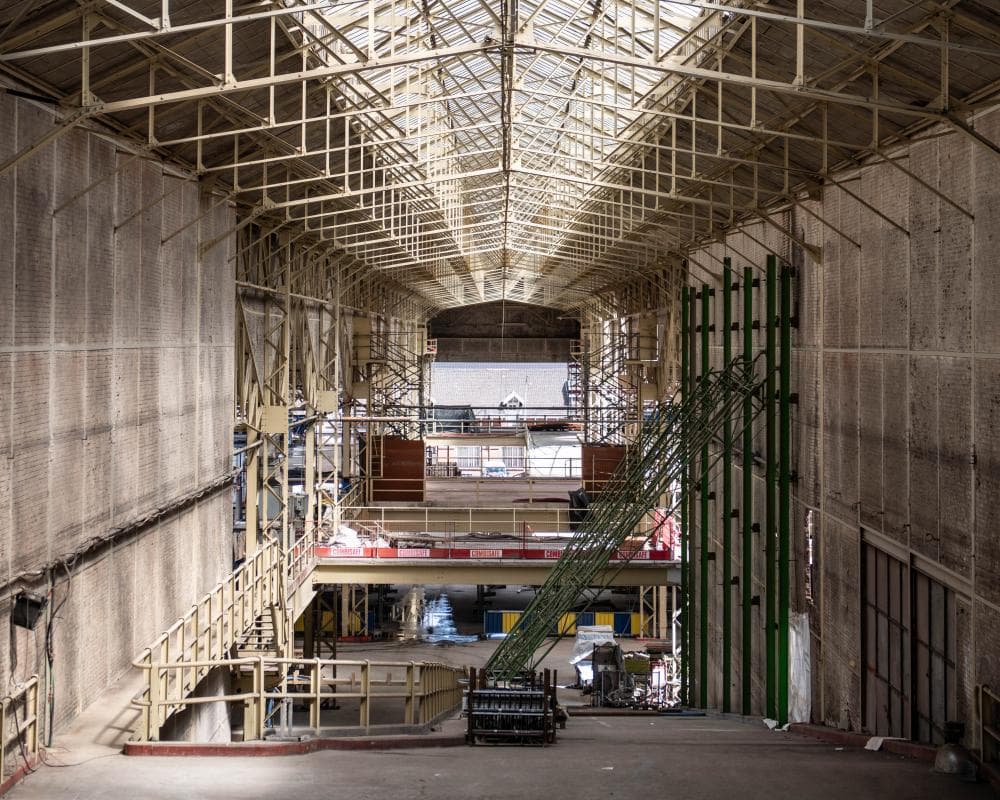Loading...
Please wait for a bit
Please wait for a bit

Click any word to translate
Original article by Philip Oltermann European culture editor
A year before its scheduled opening on 28 November 2026, building works at Kanal, a new contemporary art museum in Brussels, are running on time.
Housed in a remodelled former Citroën garage on the north-western edge of the city centre, the centre is 95% complete. Curators are putting the finishing touches to an opening show that will feature works by Matisse, Picasso and Giacometti on loan from the Centre Pompidou in Paris. Trilingual wall texts in English, Dutch and French have already been signed off.
With 12,500 sq metres of exhibition space over five floors, an architecture centre, restaurants and live performance venues, the museum will be bigger than the original Tate Modern in London, the Palais de Tokyo in Paris and the Guggenheim Bilbao. The investment reflects a will to turn the administrative capital of Europe into a cultural destination in its own right.
But in recent weeks, the conversation around Kanal’s opening has moved from “when” to “if”. A year and a half on from Belgian regional elections, a functioning government for the semi-autonomous Brussels-Capital region is still nowhere in sight. The only certainty seems to be the predicted austerity measures and mooted plans to slash Kanal’s budget by more than half.
“We never anticipated that 12 months before opening, and 18 months after the election, there would be no government,” said the museum’s director, Kasia Redzisz. “If there isn’t a decision on the budget, we risk having to stop construction, threatening the entire project’s future.”
Plans to equip the Belgian capital with a museum that doesn’t just showcase but also collects contemporary art go back at least a quarter of a century. Neither Brussels’ modern art gallery Wiels nor the more classical Bozar Centre for Fine Arts have their own collections. In the absence of such an institution, collections by significant Belgian artists such as Marcel Broodthaers have been bought by MoMA in New York and shipped to the US.
In 2001, the American curator Michael Tarantino was recruited to head up an arts centre but the project was hampered by political infighting and shelved after Tarantino’s death in 2003.
Thirteen years later, under the watch of the governing socialist PS party, a compromise was reached to transform the 1934-built former Citroën garage on the Place de l’Yser into Kanal.
The sheer scale of the plans drew criticism from the outset.
“It’s a nation state-sized project done by a regional government, a technocratic decision that has been amplified out of all proportion by consultants and advisers,” said Dirk Snauwaert, the director of Wiels, which does not receive structural financial support from the Brussels region. “Who thinks this is doable?”
The formalised partnership with the Centre Pompidou, limited to five years after Kanal’s opening, will cost Brussels €2m (£1.75m) a year. The connection with the Paris arts complex has been greeted with scepticism by some Flemish speakers, who make up 60% of Belgium’s population but who are a minority in the capital, raising suspicions of French colonial attitudes.
“Kanal is a really significant project, but the relationship with the Pompidou was complicated and confusing from the outset,” said Chris Dercon, the Belgian former director of Tate Modern who now runs Fondation Cartier in Paris. “Why do we need the Pompidou collection in Brussels when we have some of the best private collections in Europe right here in Belgium?”
Kanal’s supporters say such controversies are inevitable for a project with global ambitions and that similar objections were levelled at arts centres now seen as indispensable to the fabric of their cities such as Tate Modern and Paris’s own Centre Pompidou.
Redzisz said that Kanal, under her leadership, would focus on championing contemporary artists who were either born in or who live in Belgium, and said the museum would create 780 direct and indirect jobs and inject €144.4m into the Brussels economy every year.
The arts complex includes 20,000 sq metres of public space and a playground designed by the Turner prize-winning collective Assemble. Kanal has also organised workshops to prepare children from 27 nearby schools for the opening.
“It’s absolutely essential for Brussels to have this space,” said Ann Demeester, a Belgian art historian who is the director of the Kunsthaus Zürich in Switzerland. “This is the symbolic heart of Europe, a city full of artists that is as edgy as Berlin used to be.”
The deadlock in the Brussels-Capital region has been running for 537 days and could surpass the previous record.
“We must find €1bn in savings out of a total budget of €7bn,” said a spokesperson for the Francophone centrist party Les Engagés, one of six parties at the negotiating table. “All departments and projects will have to contribute to this collective effort and the Kanal project will not be exempt.”
A spokesperson for the Flemish Green party said: “The current ambitions of Kanal, a project that falls outside the core competencies [of the Brussels regional government], will have to be severely curtailed. We will have to see what is possible with a smaller budget.”
According to reports in the newspaper L’Echo, the liberal party MR has proposed reducing Kanal’s €35m annual operating budget by 60%, though it has not made this proposal official.
Wiels’s Snauwaert is urging officials to find savings in the costly tie-in with the Pompidou. “We all hope our money won’t be wasted,” he said. “But the wise decision would be to cut ties with the Pompidou and invest the money in culture instead.”
Redzisz said: “There is a new fiscal reality, which we understand, and we are prepared to take a cut like everyone else.
“I still believe that politicians will realise the huge potential of this project as a destination, as a landmark for Brussels. Abandoning Kanal now would amount to cultural suicide.”